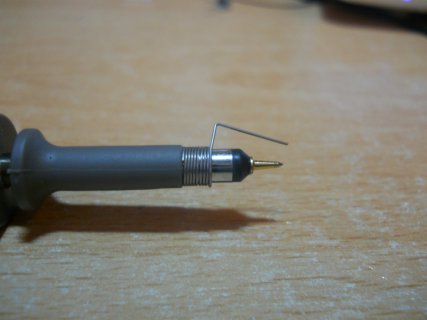You are using an out of date browser. It may not display this or other websites correctly.
You should upgrade or use an alternative browser.
You should upgrade or use an alternative browser.
100kHz noise on power supply when USB is plugged in
- Thread starter dudmahn
- Start date
- Status
- Not open for further replies.
Several ways to skin a cat, but we lack details as to what kind of cat.
If the primary purpose of this circuit is to measure analog signals then do yourself a favor and separate the power to the analogs with a separate power supply. Best choice would be a linear supply. Switching supplies and analog signals never play nice together unless you stick heavy filtering or spend significant amounts of time custom making the supply. Analog measurement circuits usually don't need much current so you don't need anything crazy. (LM7805 and some caps, may not even need a heatsink)
Also the connection you used for the Scope makes me cringe, get ride of the lengths of wire . Your picking up all the electronics in the room with those antennas. Don't forget that your scope is grounded, that will cause a ground loop when you plug most grounded USB Hubs/PC's into the system regardless of the VUSB being cut.
If the primary purpose of this circuit is to measure analog signals then do yourself a favor and separate the power to the analogs with a separate power supply. Best choice would be a linear supply. Switching supplies and analog signals never play nice together unless you stick heavy filtering or spend significant amounts of time custom making the supply. Analog measurement circuits usually don't need much current so you don't need anything crazy. (LM7805 and some caps, may not even need a heatsink)
Also the connection you used for the Scope makes me cringe, get ride of the lengths of wire . Your picking up all the electronics in the room with those antennas. Don't forget that your scope is grounded, that will cause a ground loop when you plug most grounded USB Hubs/PC's into the system regardless of the VUSB being cut.
I recently had a similar issue on a PCB that contained plenty of parts designed to reduce noise (linear regulators with good rejection in the expected power supply noise region feeding my analog circuitry, ferrites & LCL filters).
It turned out to be the ground lead on the oscilloscope probe (as I understand it - inductance which picks up nearby EM fields and rings/resonates; I was seeing 2 volt pk-pk spikes on a 3.3V signal at the frequency of a nearby SMPS).
It was fixed by using low noise probe techniques such as:

(Source: https://electronics.stackexchange.c...his-springy-type-oscilloscope-probe-accessory)
When I used this technique, the spikes went away completely - i.e. I wasn't seeing a true representation of the actual voltage/waveform at that point in the circuit, I was seeing 'fake' noise introduced by my bad probing. I've now got a new revision of the PCB that uses tiny u.FL connectors at all the important analog points I want to probe so I just use a direct u.FL to BNC lead into my scope.
(Note to anyone considering using u.FL probe points: you'll need to keep track of how many times you use the u.FL to BNC lead - the u.FL connectors are only rated for about 30 actuations, so it's a 'disposable' lead. They're cheap on eBay.)
It turned out to be the ground lead on the oscilloscope probe (as I understand it - inductance which picks up nearby EM fields and rings/resonates; I was seeing 2 volt pk-pk spikes on a 3.3V signal at the frequency of a nearby SMPS).
It was fixed by using low noise probe techniques such as:

(Source: https://electronics.stackexchange.c...his-springy-type-oscilloscope-probe-accessory)
When I used this technique, the spikes went away completely - i.e. I wasn't seeing a true representation of the actual voltage/waveform at that point in the circuit, I was seeing 'fake' noise introduced by my bad probing. I've now got a new revision of the PCB that uses tiny u.FL connectors at all the important analog points I want to probe so I just use a direct u.FL to BNC lead into my scope.
(Note to anyone considering using u.FL probe points: you'll need to keep track of how many times you use the u.FL to BNC lead - the u.FL connectors are only rated for about 30 actuations, so it's a 'disposable' lead. They're cheap on eBay.)
Last edited:
- Status
- Not open for further replies.

